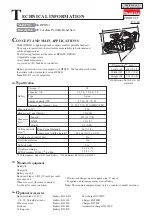
3
• DO NOT OPERATE ELECTRIC TOOLS NEAR FLAMMABLE LIQUIDS OR IN
GASEOUS OR EXPLOSIVE ATMOSPHERES.
Motors and switches in these tools
may spark and ignite fumes.
• STAY ALERT, WATCH WHAT YOU ARE DOING, AND USE COMMON SENSE. DO
NOT USE THE MACHINE WHEN YOU ARE TIRED OR UNDER THE INFLUENCE
OF DRUGS, ALCOHOL, OR MEDICATION.
A moment of inattention while
operating power tools may result in serious injury.
• DO NOT ALLOW FAMILIARITY (gained from frequent use of your saw) TO
REPLACE SAFETY RULES.
Always remember that a careless fraction of a second
is sufficient to inflict severe injury.
Additional Safety Rules for Table Saws
WARNING: ALWAYS USE SAFETY GLASSES.
Everyday eyeglasses are NOT
safety glasses. Also use face or dust mask if cutting operation is dusty. All users and
bystanders MUST ALWAYS wear certified safety equipment:
• Eye protection: AS/NZS1337 Eye Protectors for Industrial Applications;
• Hearing protection: AS/NZS1270 Acoustics – Hearing Protection;
• Respiratory protection: AS/NZS1716 Respiratory Protective Devices.
WARNING:
Do not expose to rain or use in damp locations.
•
AVOID AWKWARD POSITIONS
, where a sudden slip could cause a hand to move
into a saw blade.
•
NEVER REACH IN BACK OF, OR AROUND, THE CUTTING TOOL
with either hand
to hold down the workpiece.
•
KEEP ARMS, HANDS AND FINGERS AWAY
from the blade to prevent serious
injury.
•
USE A PUSH STICK THAT IS APPROPRIATE TO THE APPLICATION TO PUSH
WORKPIECES THROUGH THE SAW.
A push stick is a wooden or plastic stick,
usually homemade, that should be used whenever the size or shape of the
workpiece would cause you to place your hands within 152 mm (6") of the
blade.
•
USE HOLD-DOWNS, JIGS, FIXTURES OR FEATHER BOARDS TO HELP
GUIDE AND CONTROL THE WORKPIECE.
Accessories for use with your tool
are available at extra cost from your local dealer or authorized service center.
Instructions for making a push stick, a narrow rip auxiliary fence, a push block
and feather boards are included in this manual.
•
DO NOT PERFORM RIPPING, CROSSCUTTING OR ANY OTHER OPERATION
FREEHAND.
•
NEVER
reach around or over saw blade.
•
STABILITY
. Make sure the table saw is firmly mounted to a secure surface before
use and does not move.
•
NEVER CUT METALS
,
CEMENT BOARD OR MASONRY.
Certain man-made
materials have special instructions for cutting on table saws. Follow the
manufacturer’s recommendations at all times. Damage to the saw and personal
injury may result.
•
THE PROPER THROAT PLATE MUST BE LOCKED IN PLACE AT ALL TIMES
to
reduce the risk of a thrown workpiece and possible injury.
•
USE THE CORRECT SAW BLADE FOR THE INTENDED OPERATION.
The blade
must rotate toward the front of the saw. Always tighten the blade arbor nut
securely. Before use, inspect the blade for cracks or missing teeth. Do not use a
damaged or dull blade.
•
NEVER ATTEMPT TO FREE A STALLED SAW BLADE WITHOUT FIRST TURNING
THE MACHINE OFF AND DISCONNECTING THE SAW FROM THE POWER
SOURCE.
If a workpiece or cut-off piece becomes trapped inside the blade guard
assembly, turn saw off and wait for blade to stop before lifting the blade guard
assembly and removing the piece.
•
NEVER START THE MACHINE
with the workpiece against the blade to reduce the
risk of a thrown workpiece and personal injury.
•
NEVER have any part of your body in line with the path of the saw blade.
Personal injury may occur.
•
NEVER PERFORM LAYOUT, ASSEMBLY OR SET-UP WORK
on the table/work
area when the machine is running. A sudden slip could cause a hand to move
into the blade. Severe injury can result.
•
CLEAN THE TABLE/WORK AREA BEFORE LEAVING THE MACHINE.
Lock
the switch in the “OFF” position and disconnect from the power source to
prevent unauthorized use.
•
DO NOT leave a long board (or other workpiece) unsupported so the spring
of the board causes it to shift on the table resulting in loss of control and






































